The linear stepper motor can move linearly or linearly. As a power source, a rotating electric motor needs to be converted into a linear motion by means of gears, a convex wheel structure and a belt or a steel wire. This paper mainly explains the working principle of linear stepping motor. Firstly, the structure of linear stepping motor is introduced. Secondly, the basic principle and working principle of linear stepping motor are introduced. Finally, its advantages and applications are expounded.
Introduction to linear stepper motorA linear stepping motor, or linear stepper motor, is produced by a magnetic rotor core that interacts with a pulsed electromagnetic field generated by a stator, and a linear stepping motor converts rotational motion into linear motion inside the motor.
Linear stepper motor structureThe following figure shows the mechanism for driving a linear motion of a rotary stepper motor: a floppy disk drive (FDD) head movement mechanism. In the past, the mechanism of the 3.5-inch FDD used the screw mechanism of the figure (a). Although the gap was small, the efficiency was low, so the high-speed operation was difficult, but it was widely used because of the low price. The mechanism of Figures (b), (c), and (d) is the use of 5.25-inch FDD, and the belt type of (c) is used in the transfer cylinder drive of the printer. These linear conversion mechanisms can be replaced with the linear stepping motor of Fig. (e).
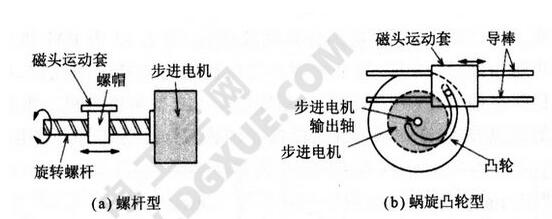
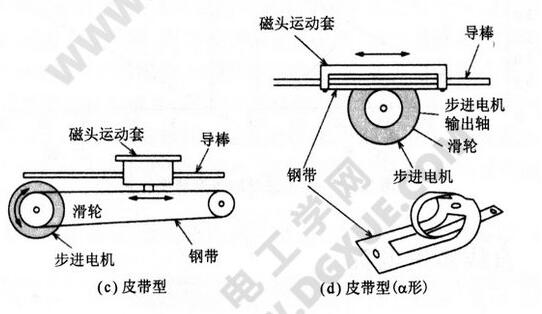
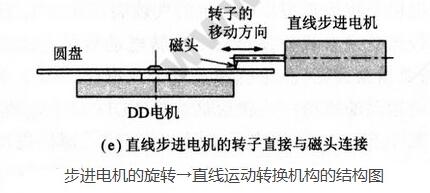
Compared with the rotary type, the linear stepping motor can directly move linearly, which can make the machine compact; sensitive to the load inertia; if the stroke is long, the air gap will be larger than the rotary type, which will cause problems such as decreased efficiency, etc. Pay attention to the use and use environment.
Basic principle of linear stepper motorA screw and a nut are engaged, and a certain method is adopted to prevent the screw nut from rotating relative to each other, thereby causing the screw to move axially. In general, there are currently two ways to achieve this conversion. The first is to have a internally threaded rotor in the motor, with the internal thread of the rotor meshing with the screw for linear motion, and the second is a screw. The motor shaft is linearly moved outside the motor by an external drive nut and screw. The result of this is that the design is greatly simplified, enabling the use of linear stepper motors for precise linear motion without the need for external mechanical linkages in many applications.
Linear stepper motor working principle (Sawyer as an example)The linear stepper motor has a three-phase VR type. Here we describe the operating principle of the permanent magnet rotor: Sawyer principle. The figure below shows the working principle of a linear stepper motor using the Sawyer principle.
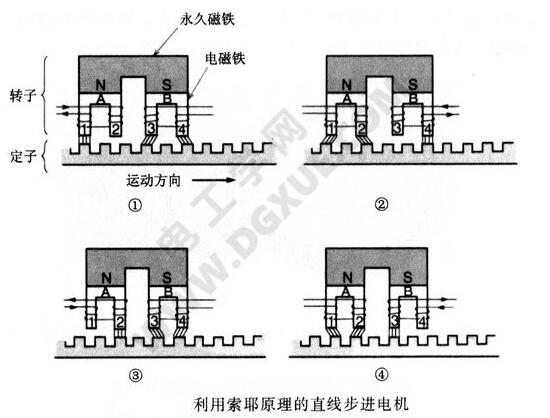
If the current is switched in the order of 1, 2, 3, and 4, the two currents are excited by the coil current to generate opposite polarities, superimposed with the magnetic flux generated by the permanent magnet, and the magnetic flux of one magnetic pole is added, and the other is Subtraction, when the magnetic flux generated by the winding is the same as that of the permanent magnet, the magnetic flux of the subtracting magnetic pole is zero. At this time, the magnetic flux of the permanent magnet passes through the exciting magnetic pole in the same direction, and passes through the two magnetic poles of the stator yoke and the mover. Return to the other magnetic pole of the permanent magnet, 1, 2, 3, 4 sequentially switch the excitation current, and the rotor moves 1/4 of the stator pitch to the right each time. This is the working principle of Sawyer linear stepper motor.
Advantages of linear stepper motors (compared to traditional stepper motors)(1) High speed responsiveness
In general, mechanical transmissions are orders of magnitude larger than the dynamic response time of electrical components. Because some mechanical transmission parts such as lead screws with large response time constant are eliminated in the system, the dynamic response performance of the whole closed-loop control system is greatly improved, and the reaction is extremely sensitive and quick.
(2) High precision
Since the mechanical transmission mechanism such as the screw is eliminated, the tracking error caused by the delay of the transmission system during the interpolation is reduced. Through the linear position detection feedback control, the positioning accuracy of the machine tool can be greatly improved.
(3) High transmission rigidity and stable thrust
"Direct drive" increases the stiffness of the drive. At the same time, the layout of the linear motor can be arranged according to the shape of the machine guide rail and the force of the table during the movement. It is usually designed to be evenly symmetrical, making its motion thrust stable.
(4) Fast speed, short acceleration and deceleration process
Linear motors were first used mainly for maglev trains (up to 500km/h) and are now used in machine feed drives to meet the maximum feed rates for ultra-high-speed cutting (up to 60-100m/min or higher). It is ok. Due to the high-speed responsiveness of the “zero transmissionâ€, the acceleration and deceleration process is greatly shortened, so that the high speed can be achieved instantaneously at the time of starting, and the instantaneous stop can be instantaneously performed at high speed. The acceleration can generally reach 2 to 10 g (g = 9.8 m / s 2).
(5) Unlimited length of stroke
By linearly stepping the stator of the motor on the guide rail, the stroke length of the moving member can be extended indefinitely.
(6) Low noise during operation
Since the mechanical friction of the components such as the drive screw is eliminated, and the guide rail pair can adopt the rolling guide or the magnetic pad suspension guide (no mechanical contact), the motion noise is greatly reduced.
(7) High efficiency
Since there is no intermediate transmission link, the energy loss during mechanical friction is eliminated.
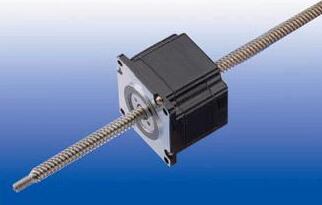
Linear stepper motors are widely used in many high-precision requirements including manufacturing, precision calibration, precision fluid measurement, and precise positional movement.
Yuchai High Voltage Generators with Yuchai Diesel Engine, HV AC Generator
·Engine and alternator shall be mounted on a same frame steel skid.
·Small size, low weight, easy to operating, installation and maintenance.·World most famous brand diesel engine: Yuchai engine
·World famous brand High Voltage AC alternator: Stamford, Leroy Somer, Marathon, Faraday, etc
·Advanced and reliable controller: Auto start, AMF & Remote control by PC with RS232/485
·Full range protect function and alarm shutdown feature.
·Comply with ISO8528 national standard and ISO9001 quality standard.
. Voltage: 3kV, 3.3kV, 6kV, 6.3kV, 6.6kV, 10kV, 10.5kV, 11kV,13.8kV
Yuchai Hv Genset,Yuchai Hv Generator,Yuchai 10Kv Generator,Yuchai High Voltage Generator
Guangdong Superwatt Power Equipment Co., Ltd , https://www.swtgenset.com